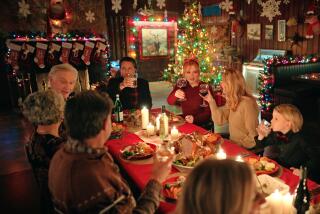Preserving Historic Traditions : Homemade Wreaths Reminiscent of 18th-Century Decor
- Share via
WILLIAMSBURG, Va. — This time of year, residents along historic Duke of Gloucester Street are storing up boxwood and pine, apples, nuts and berries, to decorate the restored 18th-Century buildings of the former Virginia capital.
It is a Christmas tradition that dates to the late 1930s and early 1940s--when the restoration dream of John D. Rockefeller Jr. and the Rev. W.A.R. Goodwin was just coming to fruition.
Experts at Colonial Williamsburg admit no one really knows exactly how the early residents of Williamsburg prepared their homes for the Christmas season. But they speculate that early residents of the Colonial city used what was at hand--natural greens, fruits and berries.
“We’re not real sure what they did in the 18th Century,” said Martha Marquardt, assistant supervisor in the flower section of Colonial Williamsburg. “We don’t think it was quite as elaborate.
‘A Festive Occasion’
“We do know it was a festive occasion to celebrate the birth of Christ,” said Marquardt, who has been making wreaths for the retored homes and exhibition buildings for the past 18 years. “There was a lot of socializing with relatives and friends.”
With that idea in mind, the staff had adopted a 20th-Century theme “using what we think they would have used in the 18th Century,” said Marquardt.
For three days in November, Libby Oliver Hodges, supervisor of the CW flower section, conducts workshops to instruct beginners on making the traditional fruit wreaths, apple fans, and mixed fruit cones that charm visitors to the historic village.
“They come from all over the country,” Marquardt said. “We had a lady who came for a number of years from Michigan.”
Few Giant Bows
Visitors will find few giant bows adorning the natural wreaths and garlands along the streets.
“It’s all native and natural material,” she said. “Ribbon was very precious in the 18th Century and was used very sparsely.”
Currently the staff is decorating more than 300 boxwood, balsam or cedar wreaths to adorn the buildings that are regular stops on visitors’ tours. In buildings such as the Governor’s Palace, the staff prepares decorations for tables and doorways.
Residents along Duke of Gloucester Street prepare their own wreaths for their homes based on the natural theme.
The preparations must be completed by Dec. 15, when the Colonial Williamsburg Fife and Drum Corp. marches down the historic street to begin annual Grand Illumination festivities.
The Illumination, which commences the 10-day celebration leading up to Christmas Day, includes caroling, dances, and storytelling on the part of Colonial Williamsburg actors and interpreters.
The Colonial Williamsburg Foundation has published a book, “Colonial Williamsburg Decorates for Christmas,” that provides step-by-step instructions for making its famous decorations.
Here are instructions excerpted from that book for making a Mixed Fruit Wreath:
--1 basic boxwood wreath constructed on an 20-inch wreath frame
--20 pieces of No. 16 gauge floral wire in 18-inch lengths
--2 oranges
--6 medium red apples
--6 limes
--6 lemons
--20-24 small white pine cones
--20-24 4-inch floral picks
Push a piece of wire midway through the side center of each orange, apple, lime and lemon so that it protrudes an equal distance on each side of the fruit. Bend the wires into a “U” shape toward the stem end of each piece of fruit.
Oranges on Wreath
Center an orange at the top of the wreath. Attach the orange to the wreath by holding the wire ends two inches apart and pushing them through the middle of the boxwood. Twist the wires several times at the back of the wreath to secure the orange.
Cut off any excess wire. Center the second orange at the bottom of the wreath. Attach it in the same manner.
Center an apple at each side of the wreath. Attach them in the same manner. Position and attach an apple above and below the center apples leaving room for a lime or lemon.
Position and attach a lime on each side of the orange at the bottom of the wreath. Position and attach two limes between the top and middle apple on each side of the wreath.
Position and attach a lemon on each side of the orange at the top of the wreath. Position and attach a lemon on each side of the lower apple on each side of the wreath.
Wire the white pine cones on four-inch floral picks by looping the wire on the picks in and around the bottom row of scales on the cone. Wrap the wire tightly around the floral pick several times.
Place the pine cones on the outside edges of the fruit around the wreath.
More to Read
Sign up for The Wild
We’ll help you find the best places to hike, bike and run, as well as the perfect silent spots for meditation and yoga.
You may occasionally receive promotional content from the Los Angeles Times.






